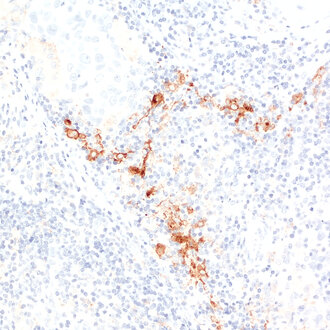
| Cat. No. HS-495 111 |
100 µg purified IgG, lyophilized. Albumin and azide were added for stabilization. For reconstitution add 100 µl H2O to get a 1mg/ml solution in PBS. Then aliquot and store at -20°C to -80°C until use. Antibodies should be stored at +4°C when still lyophilized. Do not freeze! |
| Applications | |
| Clone | SY-162E11 |
| Subtype | IgG1 (κ light chain) |
| Immunogen | Synthetic peptide corresponding to residues near the carboxy terminus of human CD169 (UniProt Id: Q9BZZ2) |
| Reactivity |
Reacts with: human (Q9BZZ2). No signal: mouse (Q62230). Other species not tested yet. |
| Remarks |
IHC: Antigen retrieval with citrate buffer pH 6 is required. |
| Data sheet | hs-495_111.pdf |

Transmembrane staining of CD169-positive macrophages in a human lymph node
CD169, also known as Siglec-1 or sialoadhesin, is a cell surface receptor that is most frequently expressed by certain macrophage subsets in lymphoid tissue: the marginal metallophilic macrophages (MMMs) of the spleen and the macrophages in the subcapsular sinus and medulla of lymph nodes (1). To a lesser extent, CD169 is also found on macrophages in liver, lung and colon. CD169⁺ macrophages are involved in immunological tolerance, antigen presentation and defense against infectious agents such as viruses (2) and play a tumor-suppressive role in malignant tumors (3). In the intact brain, CD169 stains subpopulations of macrophages in the choroid plexus, leptomeninges and circumventricular organs (4). CD169 is regulated by contact with plasma proteins, and damage to the blood-brain barrier leads to the expression of CD169 on microglia and macrophages within the parenchyma (4). In glioblastoma, CD169⁺ tumor-associated macrophages were shown to exert an important anti-tumor role by promoting the phagocytosis of apoptotic tumor cells, enhancing the activation of tumor-specific T cells, and supporting lymphocyte infiltration into the tumor microenvironment (5).